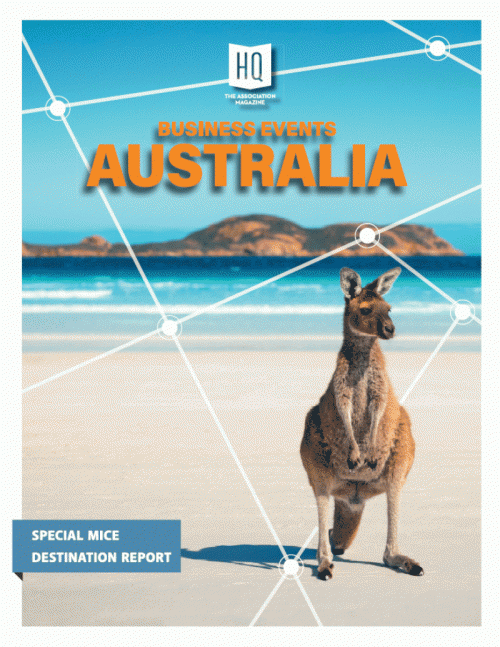“The blend of digital and in-person strategies will keep associations ahead of the curve”

Olena Lima (on the cover) is the Founder and Principal Consultant of MemberBoat, a Sydney-based digital marketing agency dedicated to helping professional associations and other membership organisations embrace emerging digital marketing tools. She started working with associations 15 years ago and quickly fell in love with the sector. After seven years, she founded MemberBoat and is also the host of the Membership Marketing School and the Association Hub Podcast. We couldn’t miss this chance to sit down with her and exchange a few words:
What are the priority factors in the decision-making of the associations you work with?
In today’s landscape, if you’re not embracing digital tools now, you’re already behind. It doesn’t necessarily mean you have to transform all your events into digital or hybrid - people need and love face-to-face interactions − since digital interactions begin well before the event itself. This may include registration or Expression of Interest online forms, social media and newsletter promotions, speaker submissions and registrations, online discussions prior and after the event, and so on. While I firmly believe that nothing can surpass the value of face-to-face communication, digitalisation plays a crucial role in making events more accessible for those who can’t attend in person, making associations more inclusive. The trend towards digital growth has not been held back by the return of the ‘old normal.’ Instead, it has complemented traditional event planning, offering a more integrated and comprehensive approach to member engagement and event management. Associations are prioritising a blend of digital and physical strategies to maximise their reach and impact, ensuring that they cater to diverse member needs.
If we talk about the conference of the future, what new networking space are we talking about? What will be the third evolution to emerge from online and hybrid?
With emerging technologies, we’re moving towards immersive experiences that seamlessly blend physical and digital elements, making events more engaging, interactive, and memorable. In my view, the third evolution of conference technology will likely focus on creating personalised, AI-driven experiences that anticipate and meet attendee needs in real time. This means leveraging data analytics and machine learning to provide customised content, networking opportunities, and recommendations that adapt to the attendee’s journey throughout the event. For example, if an attendee shows interest in a particular topic, the AI system could dynamically adjust their schedule to include related sessions or suggest relevant exhibitors to visit. This level of personalisation enhances the attendee experience, making it more meaningful and valuable. Moreover, integrating these technologies will make events more accessible and inclusive. This inclusivity not only broadens the reach of the event but also enriches the diversity of perspectives and experiences, making the event more valuable for all participants.
“The future of conferences lies in harnessing the power of emerging tools. By blending physical and digital elements, we can transform how attendees engage with events, making them more impactful and memorable.”
How would you define this experiential era that events are currently undergoing? How can we move from a content context to an experience context through emotional involvement?
Events have never been just about content. They’re fundamentally about people, connections, and emotions. The true essence of any event lies in the human connections and memorable experiences it fosters. The more opportunities event organisers create for meaningful interactions and unforgettable moments, the more successful the event will be. Technology plays a pivotal role, it’s not the core of the event. Instead, it’s a powerful enabler that enhances efficiency and allows organisers to focus on what truly matters – people interactions, emotions, and creating memorable experiences. For example, interactive technologies, such as live polling apps or Q&A platforms, can make sessions more engaging by allowing real-time audience participation. Similarly, networking apps can match attendees with similar interests, facilitating meaningful connections that might not happen otherwise.
Furthermore, experiential elements such as immersive VR experiences or augmented reality exhibits can transform how attendees engage with content in a dynamic and memorable way. A VR simulation could allow attendees to explore a new product in a virtual environment, providing a deeper understanding and connection to the material. Ultimately, the goal is to create an environment where attendees feel emotionally engaged and connected. This is where technology shines – by taking care of logistical and operational tasks, it frees up organisers to focus on crafting these experiences. In my view, successful events are those that prioritise people and emotions, creating spaces where attendees can interact, share experiences, and build lasting relationships.

Do you think the associations you have worked with have a clear vision of what they want to achieve in terms of legacy and social impact?
Associations have begun to navigate new concepts adapted to today’s reality, planning their events to be more interactive, relevant, and inclusive. This shift ties directly into my response above – if we recognise that events are fundamentally about human connections and emotions, the next step is to consider their long-term impact, their legacy. To me, ‘meetings with purpose’ means designing events that go beyond the traditional metrics of success – attendance numbers and financial returns – to consider the deeper, more meaningful impacts. It’s about ensuring that every aspect of the event, from the breakout sessions to the networking activities, aligns with a greater purpose and contributes to the overall industry the association serves.
By focusing on these legacy elements, we can help associations create events that are not only successful in the short term but also leave a lasting positive impact. This approach enhances the value of the event for attendees, strengthens the association’s reputation, and fosters longterm loyalty and engagement.
How do you communicate for impact in event-focused marketing campaigns? What are the associations’ big mistakes in this regard, and how should traditional and digital channels work together?
The key to successful event marketing lies in continuous innovation, balancing technology with genuine human interaction, and clearly communicating the event’s broader impact. By focusing on these aspects, event organisers can create experiences that are not only impactful and memorable but also foster a strong, purpose-driven community. Attendees want to know that their participation contributes to something significant. This could be through sustainability initiatives, community outreach programmes, or industry advancements. The biggest mistake, in my view, is relying on what was successful before. This can lead to stagnation. The landscape is constantly evolving, and unless we stay abreast of new trends and member expectations, it’s impossible to create a successful and sustainable event. Another common mistake is relying too heavily on technology for the community elements. While online community platforms foster connections and conversations, they’re just tools. The true essence of community lies in meaningful, real-world connections. Online platforms can facilitate initial interactions, but it’s the shared experiences and personal interactions that truly build strong, lasting relationships.
"Organising a conference in 2024 means recognising that the old priorities of the baby boomers and even the Millennials need to evolve."
How can an association approach a new era of marketing and social business by appealing to the value of changing generations?
While Millennials are the main driving force of the economy, the emphasis must now be on understanding and engaging Generation Z. Their expectations and preferences are shaping the future of conferences and it’s crucial that we adapt to them. I believe, the main secret to a successful event catered to a multi-generational audience lies in co-creating experiences and incorporating audience feedback into the planning and execution. Co-creation involves actively involving different generations in the event planning process. This could be through surveys, focus groups, or social media engagement, where their opinions and preferences are solicited and acted upon. Organising a conference in 2024 means recognising that the old priorities of the baby boomers and even the Millennials need to evolve. It’s about creating events that are not only informative and engaging but also socially responsible and reflective of the values of the younger generation. This involves selecting topics that are relevant to Gen Z, such as social justice, climate change, and digital innovation, and presenting them in a way that is dynamic and interactive.
What useful tips would you leave to many associations going through difficult financial years?
One of the most effective strategies to promote events on a budget is to leverage your existing community. Your members are your most powerful marketing channel. They are already engaged and are likely to have networks filled with relevant individuals who could benefit from attending your event. This word-of-mouth approach can significantly extend your reach without the need for a large marketing budget. To facilitate this process, provide your members with the necessary tools and interesting content to make it easier for them to share information about the event. This can include pre-written social media posts, email templates and digital flyers. Encourage them to share personal stories or testimonials about their experiences with your event. Also, consider setting up an ambassador programme, where selected members are recognised for their efforts in promoting the event, with incentives such as discounts on registration fees or exclusive access to certain features of the event.
As well as empowering your community, AI and marketing automation can also play a significant role in maximising efficiency and impact. AI can segment your audience based on their interests and behaviours, allowing you to tailor your marketing efforts more precisely. For example, AI-driven analysis can identify the topics or sessions likely to appeal to specific segments of your members, allowing you to target your communications more effectively. Marketing automation tools can simplify many of the processes involved in promoting events, such as email campaigns that can nurture contacts and keep potential attendees engaged with personalised content.
Other Articles
About Us
Supported by the Union of International Associations (UIA), the International Association of Professional Congress Organisers (IAPCO) and the Interel Group, the global public affairs and association management consultancy, Headquarters Magazines serve the needs of international associations organising worldwide congresses.















